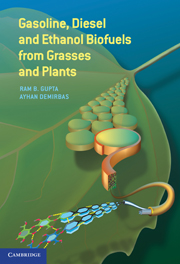Book contents
- Frontmatter
- Contents
- Preface
- 1 Introduction
- 2 Air Pollution and Global Warming from the Use of Fossil Fuels
- 3 Renewable Energy Sources
- 4 Biomass Availability in the World
- 5 Conventional Ethanol Production from Corn and Sugarcane
- 6 Ethanol from Biomass by Fermentation
- 7 Biodiesel from Vegetable Oils
- 8 Diesel from Biomass Gasification Followed by Fischer–Tropsch Synthesis
- 9 Bio-Oil from Biomass Pyrolysis
- 10 Biocrude from Biomass Hydrothermal Liquefaction
- 11 Solar and Wind Energy for Biofuel Production
- 12 Environmental Impacts of Biofuels
- 13 Economic Impact of Biofuels
- 14 Biofuel Policy
- References
- Index
10 - Biocrude from Biomass Hydrothermal Liquefaction
Published online by Cambridge University Press: 05 June 2012
- Frontmatter
- Contents
- Preface
- 1 Introduction
- 2 Air Pollution and Global Warming from the Use of Fossil Fuels
- 3 Renewable Energy Sources
- 4 Biomass Availability in the World
- 5 Conventional Ethanol Production from Corn and Sugarcane
- 6 Ethanol from Biomass by Fermentation
- 7 Biodiesel from Vegetable Oils
- 8 Diesel from Biomass Gasification Followed by Fischer–Tropsch Synthesis
- 9 Bio-Oil from Biomass Pyrolysis
- 10 Biocrude from Biomass Hydrothermal Liquefaction
- 11 Solar and Wind Energy for Biofuel Production
- 12 Environmental Impacts of Biofuels
- 13 Economic Impact of Biofuels
- 14 Biofuel Policy
- References
- Index
Summary
What Is Biocrude?
In search of renewable fuels, as early as the mid-twentieth century, researchers started to convert biomass into petroleum-like liquids. For example, Berl (1944) treated biomass using alkaline water at 230°C to produce a viscous liquid that contained 60% carbon and 75% heating value of the starting material. The liquid, termed biocrude, contains 10–20 wt% oxygen and 30–36 MJ/kg heating value as opposed to <1 wt% and 42–46 MJ/kg for petroleum (Aitani, 2004). The high oxygen content imparts lower energy content, poor thermal stability, lower volatility, higher corrosivity, and tendency to polymerize over time (Peterson et al., 2008). Hence, biocrude needs to be deoxygenated to make it compatible with conventional petroleum. Because biocrude contains less oxygen and more heating value than biomass, the hydrothermal liquefaction process is also referred to as hydrothermal upgrading. Compared with bio-oil from fast pyrolysis, biocrude produced from hydrothermal liquefaction has higher energy value and lower moisture content but requires longer residence time and higher capital costs. Typical hydrothermal liquefaction conditions range from 280 to 380°C, 70 to 20 Mpa, with liquid water present and reaction occurring for 10–60 minutes.
Hydrothermal Medium
Generally, hydrothermal medium refers to water that has been heated and compressed simultaneously. A phase diagram of pure fluid is shown in Figure 10.1; in the case of water, the critical point is 374°C and 221 bar (Note: a mixture may have a different critical point depending on the components and concentrations).
- Type
- Chapter
- Information
- Gasoline, Diesel, and Ethanol Biofuels from Grasses and Plants , pp. 158 - 174Publisher: Cambridge University PressPrint publication year: 2010
- 1
- Cited by

